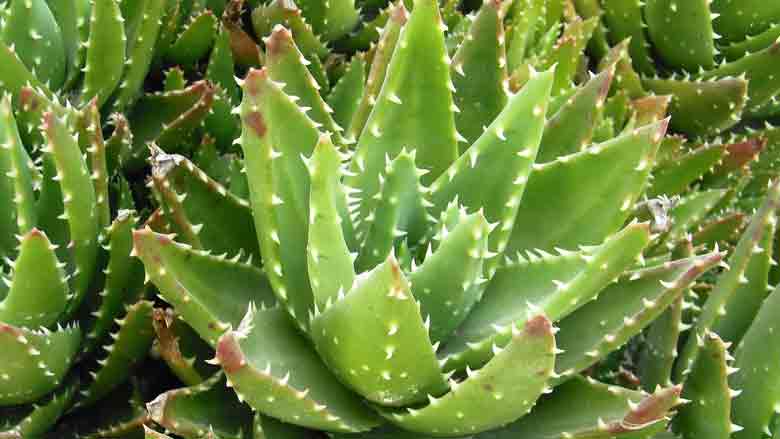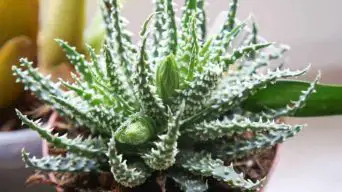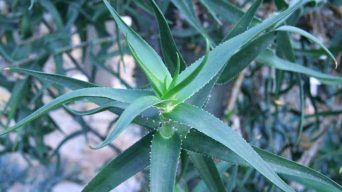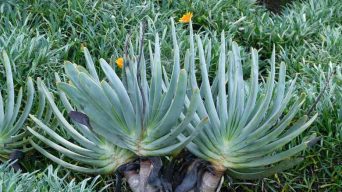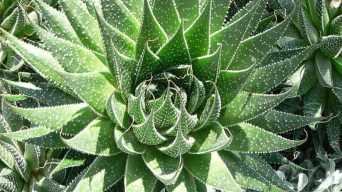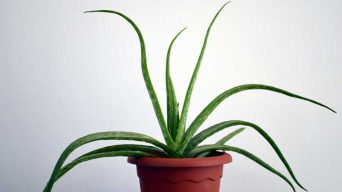Aloe brevifolia is a beautiful succulent plant that anyone can grow in their garden.
Aloes are not difficult to care for but require some attention.
Some problems can occur when you take care of your Aloe plant incorrectly.
This article will provide a complete guide about propagating and caring for Aloe brevifolia succulents at home and keeping them alive!
Overview
| Family: | Asphodelaceae |
| Genus: | Aloe |
| Botanical Name: | Aloe brevifolia |
| Common Names: | Blue Aloe, Crocodile Jaws, Crocodile Plant, Crocodile Aloe, Short-leaved Aloe |
| Origin: | Western Cape, South Africa |
| USDA Hardiness Zones: | 8 – 11 |
| Size: | 1 foot (30 cm) tall and 3 inches (7.5 cm) wide |
| Sun Exposure: | Full sun to partial shade |
| Water Needs: | Water thoroughly but infrequently |
| Soil Type: | Well-draining soil |
| Temperature: | 70˚-80°F (21˚-27°C) |
| Humidity Levels: | 40% |
Aloe brevifolia is a species of flowering plant in the family Asphodelaceae native to the Western Cape, South Africa.
Aloe brevifolia, the crocodile aloe, is a succulent type that forms clusters of rosettes that grow up to 1 foot (30 cm) tall, made of triangular fleshy leaves.
The rosettes reach a diameter of 3 inches (7.5 cm).
The leaves are light gray-green with white spines along the edge and sometimes a few more spines in rows on the underside.
The flowers are orange, tube-shaped structures that emerge at a height of 24 inches (60 cm) and can be seen in the late spring season.
Aloe brevifolia is commonly known as:
- Short-Leaved Aloe
- Crocodile Plant
- Crocodile Jaws
- Crocodile Aloe
- Blue Aloe
How To Care for Aloe Brevifolia (Short-leaved Aloe)
Aloe brevifolia care is relatively easy, but it does need to be done correctly.
Below you’ll find the essential information you need to know about caring for Aloe brevifolia.
Sun Exposure & Light Requirements
The Aloe brevifolia succulents need sun exposure to grow and thrive.
They can tolerate direct sunlight for a few hours each day but should be in an area with plenty of filtered light or partial shade during the hottest parts of the day.
Indoors, place your plants near a southern or southwest-facing window that gets plenty of bright indirect light from other windows nearby.
Outdoors provide some shade, especially during the hottest parts of the day.
This Aloe species needs at least six to eight hours of bright light each day to thrive.
Watering Requirements
Aloe brevifolia succulent plants are drought-tolerant desert plants that prefer to be watered deeply and infrequently.
Watering once a week is enough to keep them healthy and happy. The soil should be allowed to dry out before watering deeply.
You must avoid overwatering and getting water on the leaves because this can cause root rot.
When you water, it is best to use a watering can and pour the water slowly around the base of the plant.
If your succulents are drooping or leaves are wilting, this may mean they’ve been overwatered, so make sure not to add too much in one go!
If they are in pots, ensure plenty of drainage holes on the pot so it doesn’t get overwatered for too long.
Soil Requirements
The soil requirements for this succulent are a well-draining mixture. This allows the plant to retain water but not sit too long without draining out.
The ideal potting soil mixture for growing Short-leaved Aloe contains ¼ – ½ sand (or other abrasive material), perlite or pebbles, and some organic matter such as sphagnum moss or coconut coir fiber chunks.
A cactus or succulent soil mix would also work well, but you may want to add some sand to reduce the amount of perlite in such a mixture.
Temperature and Humidity
Temperature is an essential consideration for any succulent.
Aloe brevifolia plant needs a temperature range of 70° – 80° Fahrenheit (21 – 27°C) during the day and 50˚-70ºF at night to thrive.
Apart from maintaining the proper temperature, Aloe brevifolia also needs around 40% relative humidity to thrive in its environment and have optimal health.
Fertilizing
Aloe brevifolia plants are not heavy feeders and do not require fertilizer.
However, during the growing season (fall and spring), they can benefit from occasional fertilization with a balanced liquid fertilizer diluted to half strength.
The Aloe brevifolia is susceptible to over-fertilization and can be weakened by excessive fertilizing.
Potting and Repotting
Aloe brevifolia succulents are slow-growing, so they rarely need to be repotted.
They should only be transplanted when their roots have outgrown the pot or are too small.
It’s best to transplant them in the late spring or early summer to allow roots time to establish themselves before winter.
The best type of pot for Aloe brevifolia is a clay or terra cotta container with drainage holes in the bottom. This allows excess water to seep out, as these plants don’t like their roots to be too wet.
If you can’t find a pot with holes in the bottom, use gravel or broken pieces of pottery at the bottom for drainage. Be sure that these materials are kept away from the plant’s stem and base so they don’t rot.
Pruning
The Aloe brevifolia succulents do not require any pruning.
You may want to prune the succulent only if it has any dead leaves or old stems.
Pruning will help promote new growth and a more vigorous plant; otherwise, it’s unnecessary.
When you decide to prune these succulents, use sharp scissors and make clean cuts, with each cut being about an inch long for the best results. This way, there won’t be any live tissue left that could lead to the succulent rotting and dying.
The Aloe brevifolia plant will grow in a clump form, so you mustn’t cut off any of the roots when pruning, as this could lead to eventual death.
As mentioned before, only remove dead leaves or old stems from the top layer of your plants.
Pests and Diseases
The Aloe brevifolia succulent plant is susceptible to several common pests and diseases, including aphids, mealybugs, and root rot.
Pests
Aphids are small, soft-bodied insects that feed on the sap of plants by inserting needle-like mouthparts into leaves. They can cause stunting and yellowing as well as wilted leaves.
Mealybugs are also a pest; they suck plant juices from their bodies which causes leaf curling or distortion. The mealybug is not easy to spot because it blends in with the color of its surroundings and sucks up liquids, making them difficult for predators to see.
There are many ways you can control these pests.
For example, you can control aphids by spraying with water or using insecticidal soap.
Mealybugs are usually best handled by washing off the plant and ensuring that plants don’t get too wet. Alternatively, they can also be killed using neem oil or other organic compounds like alcohol.
Diseases
Root rot occurs when the soil becomes too moist or not moist enough for an extended period. This can lead to spotting on the leaves with yellowing edges that eventually turn brown before falling off. This is due to fungal growth in the roots.
Root rot is something to take seriously because it quickly spreads throughout the succulent and eventually kills it if left untreated for an extended period.
To avoid root rot, keeping the soil moist but not soggy is essential, which leads to overwatering problems. You also must ensure that overcrowded roots always have plenty of room in their pots so air circulation doesn’t become a problem.
How to Care for Aloe Brevifolia in Winter
Aloe brevifolia is a succulent plant that thrives in winter’s dry and airy conditions.
But these plants are sensitive to temperature, so they will die if you put them outside during freezing weather.
There is no need to bring your Aloes indoors when it’s 40°F (about 22°C) since this isn’t cold enough for death. But as soon as temperatures drop below about 30-35° Fahrenheit (0° C), move these plants inside before frost sets in.
The best way to overwinter aloe brevifolia succulent plants would be in a sunny spot with no drafts and temperatures around 60°F (16C).
When bringing the plant indoors, lower its watering frequency. It can stay indoors all winter without any problem.
Remember that it needs bright light and a cool temperature for healthy growth during this time of year.
How To Propagate Aloe Brevifolia (Short-leaved Aloe)
Aloe brevifolia, the Short-leaved Aloe, can be propagated by offsets or seeds.
Offsets
To grow from offsets (new plants that form in the cracks of older ones), gently remove the new plant from the mother plant and allow it to dry for a few days before replanting it on its own.
They need to be planted in a dry, clean potting mix that has been well-drained.
It should also be watered sparingly during its first year of growth to avoid rotting or splitting the stem, leading to infection and death.
Seeds
To grow from seeds, wait until they are old and dry.
Cut open the pod, remove a few, and then sow in prepared planting media into containers or pots with good drainage.
Keep warm, moist, but not soaking wet soil around your Aloe Brevifolia when it is germinating to ensure success.
Seeds will take up to several months for germination depending on conditions such as temperature, light levels, etc., so be patient!
Is the Aloe Brevifolia Toxic?
One of the most critical Aloe brevifolia care tips is understanding that this succulent plant can be mildly toxic. This means humans should never consume it.
Some animals, such as dogs or cats, could experience stomach discomfort, vomiting, lethargy, and diarrhea if eaten in large quantities.
You need to get your pet to a veterinarian immediately to avoid any more serious issues!
Final Thoughts
The Aloe brevifolia is a beautiful succulent that needs little attention to survive.
It can be grown in pots or planted outdoors and thrives with minimal watering.
This succulent is an excellent addition to any garden or home and is great for novice or expert gardeners.

